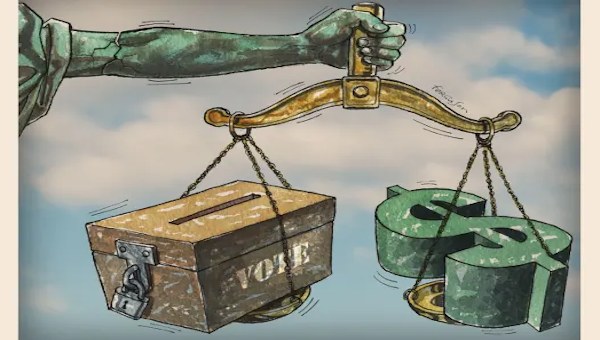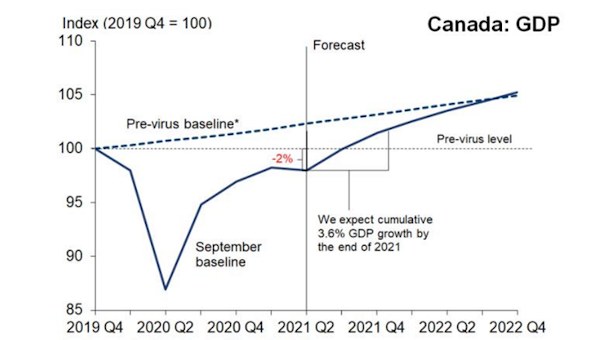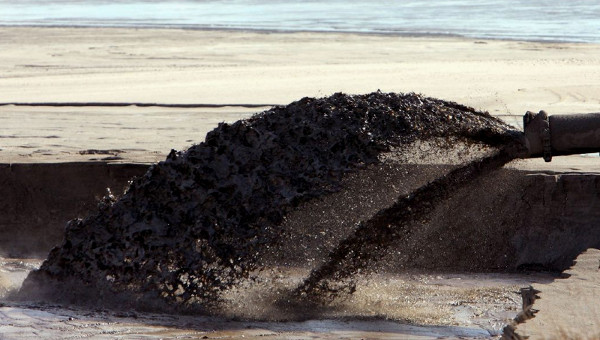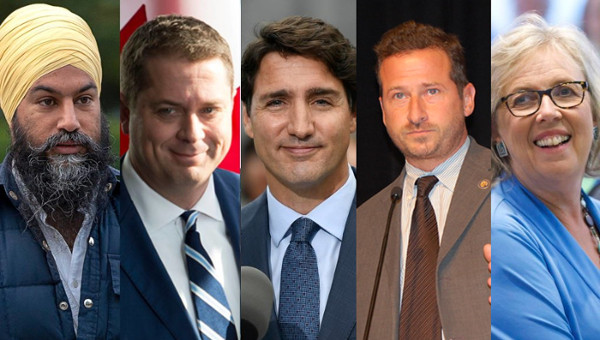Canada’s federal election October 19 was effectively a plebiscite of voter opinion on the decade-long rule by the ultra-neoliberal Conservatives (Tories) led by Stephen Harper. With some 70 per cent of the electorate declaring for “change” in successive polling, the overriding issue was which of the main opposition parties, the New Democratic Party (NDP) or the Liberals, would emerge as the party best situated to replace the Tories.
 The Official Opposition NDP entered the campaign in August with high hopes, leading the polls, buoyed by its recent victory in the Tory heartland of Alberta and enjoying new support for its principled opposition to the Tories’ repressive “anti-terror” bill C-51. But on October 19 it was the Liberals, with only 34 seats in the previous Parliament and led by a new leader Justin Trudeau, who were elected the new government, with a clear majority of the 338 seats. The NDP, winning only 44 seats, was reduced to third-party status. Its major losses were in Quebec, the province that had elected 59 NDP MPs in the previous federal election. The defeated Tories will form the Official Opposition, while the death agony of the Bloc Québécois (BQ) gets a further extension.
The Official Opposition NDP entered the campaign in August with high hopes, leading the polls, buoyed by its recent victory in the Tory heartland of Alberta and enjoying new support for its principled opposition to the Tories’ repressive “anti-terror” bill C-51. But on October 19 it was the Liberals, with only 34 seats in the previous Parliament and led by a new leader Justin Trudeau, who were elected the new government, with a clear majority of the 338 seats. The NDP, winning only 44 seats, was reduced to third-party status. Its major losses were in Quebec, the province that had elected 59 NDP MPs in the previous federal election. The defeated Tories will form the Official Opposition, while the death agony of the Bloc Québécois (BQ) gets a further extension.
A typical reaction of many worker activists was that of Suzanne MacNeil, executive vice-president of the Halifax-Dartmouth & District Labour Council and member of Solidarity Halifax, who acted as campaign manager for an NDP candidate:
“I’m disappointed that we lost so many good, progressive MPs, and that an NDP campaign that proposed substantial reforms like national child care couldn’t succeed the way we needed it to.
“I am, however, feeling no small amount of relief that we got rid of a government that was particularly nasty and determined to attack union workers, the working class in general, women, Indigenous people, immigrants, folks who live in poverty, all manner of public institutions, our environment.
“Bear in mind, this is just a moment of relief. The work ahead of us changes, but still needs to go on.”
‘Strategic Voting’
But why the Liberals and not the NDP? Superficially, the result reflected the vagaries of Canada’s grossly undemocratic electoral system under which the House of Commons is composed only of MPs who came first in their constituencies (“ridings”), irrespective of party. This “first past the post” system (FPTP) usually rewards the party scoring the highest number of votes overall with a disproportionately large number of seats.
| Canada’s Federal Election, 2015 | ||||||
|---|---|---|---|---|---|---|
| 2015 | 2011 | |||||
| Party | Seats | Votes | % of vote | Seats | Votes | % of vote |
| Conservative | 99 | 5,600,496 | 31.9 | 166 | 5,832.401 | 39.6 |
| Liberal | 184 | 6,930,136 | 39.5 | 34 | 2,783,175 | 18.9 |
| NDP | 44 | 3,461,262 | 19.7 | 103 | 4,508,474 | 30.6 |
| BQ | 10 | 818,652 | 4.7 | 4 | 889,788 | 6 |
| Greens | 1 | 605,864 | 3.4 | 1 | 576,221 | 3.9 |
| For details, see Canadian federal election, 2015 | ||||||
Had the seats at stake in this election been allocated according to the parties’ respective share of the total popular vote, the Liberals would have formed a minority government with 133 seats, while all the other parties would have elected more MPs: Tories 108, NDP 67, Bloc Québécois (BQ) 16, and the Greens 11 – one short of official party status. (These numbers fall just short of the 338 total seats due to rounding.)
In the context of a concerted movement to rid the country of the Tory government, the FPTP system put enormous pressure on anti-Tory voters to “vote strategically,” i.e. for any other party that had the best chance of defeating the government. The Liberals won that wager.
So Why the Liberals?
The reasons why will long be debated, and I don’t intend to canvass them all, but some things seem clear. It was not because of major programmatic differences between the NDP and Liberals. On the contrary, their election platforms1 seemed very similar – and this allowed quite marginal factors or events during the long campaign to result in sudden and significant shifts in their respective electorates.
Both parties promised to reverse some of the most egregious measures of the Harper era2 and each proposed new but generally modest social and legal reforms.3 They differed significantly on a few key issues; for example, the NDP committed to repealing Bill C-51 while the Liberals promised only to “repeal problematic elements.” But neither offered any real change in major features of the neoliberal regime such as the inter-imperialist military alliance structures, the trade and investment deals,4 or Canada’s dangerous dependency on petro-extractivism.
In fact, one of the weakest parts of the NDP’s platform concerned climate change, where it relies on a market-friendly “cap and trade” mechanism to limit greenhouse gas emissions, while avoiding any reference to the tar sands, the major source of Canada’s dangerously high carbon levels. Party leader Thomas Mulcair supports the Energy East project to convert the TransCanada gas pipeline to transport raw bitumen from west to east for shipment abroad – the major target of the mass environmental movement, especially in Quebec where the project entails construction of 800 km of new pipeline through ecologically sensitive farm and wet lands bordering the St. Lawrence river. On existing and new pipeline and production plans the NDP (like the Liberals) promised only tighter environmental regulations.
‘Balanced Budget’ Pledge Unbalances NDP
Overall, the NDP campaigned slightly to the “left” of the Liberals on a lengthy platform (more than 80 pages) that for the first time in the party’s history was a program for government, including even an appendix on costing so detailed that it looked like a long-term government budget. However, the economic framework throughout fell short of even the neo-Keynesianism of classic social-democracy. And it was Mulcair’s promise of a “balanced budget” with no deficits during a five-year mandate that opened the way for the Liberals, demagogically, to outflank the NDP with a promised but vague “infrastructure funding” proposal that would entail a few years (they said) of budgetary deficits.
The NDP argued that its promised social reforms could be financed without a deficit through a 2 percentage-point increase in corporate taxes (while decreasing small business taxes). But the “balanced budget” fixation looked suspiciously similar to Tory austerity. Liberal fortunes rose quickly in the opinion polls as the corporate media, which had never warmed to the NDP primarily because of its still-existing ties to the unions, boosted the Liberals as a default option if needed, while in most cases editorially endorsing the Tories.
After the Liberal ascent began, the media obligingly collaborated with Harper when he cynically sought to cultivate anti-Muslim racist support through publicly denouncing a couple of women to whom his government wanted to deny citizenship because they wore the niqab, which conceals their faces. The Tories’ maneuver was most likely aimed at winning support from the pro-independence Bloc Québécois (BQ) that would otherwise have gone to the NDP. It seemed to work. BQ leader Gilles Duceppe pounced on the issue, the media blew it up, and NDP support in Quebec continued to decline.
But the BQ’s tactic, while it may have gained it some votes, reminded many Québécois of the xenophobic Charter of Values promoted by its provincial partner, the Parti Québécois, which had played a major role in the PQ’s defeat last year. And Mulcair, to his credit, stood fast on the NDP’s support of secularly inclusive citizenship (a position shared with the Liberals, whom the media ignored in this respect). In the end, the niqab politics probably did little damage to the NDP.
NDP Now Established in Quebec
The NDP’s “orange wave” in 2011, which boosted it to Official Opposition, was centered on its impressive and unexpected victory in Quebec, where it took 59 of the province’s 75 seats. On October 19 the party lost most of those seats. However, its results merit some analysis.
| Quebec Results, 2015 and 2011 | ||||
|---|---|---|---|---|
| 2015 | 2011 | |||
| Party | Seats | % of vote | Seats | % of vote |
| Conservative | 12 | 16.7 | 5 | 16.5 |
| Liberal | 40 | 35.7 | 7 | 14.2 |
| NDP | 16 | 25.4 | 59 | 42.9 |
| BQ | 10 | 19.3 | 4 | 23.4 |
| Greens | 0 | 2.3 | 0 | 2.1 |
| Compiled from Wikipedia and Elections Canada | ||||
Although the NDP’s share of the Quebec vote fell to just over 25 per cent (from 43 per cent in 2011), and the Liberals more than doubled their vote, winning a majority of seats, the NDP came second, ahead of all other parties including the BQ – which thanks to the FPTP system increased its seats while registering its smallest support in its 25-year existence. Moreover, the ethnic divide in Quebec produces different voting patterns between majority Francophone and non-Francophone citizens. The NDP’s support declined most markedly among the non-Francophones, who voted massively for the Liberals. Support for the NDP was probably 30 per cent or more among Francophones. A riding-by-riding analysis of the popular vote will likely confirm this.
In fact, support for the federal NDP remains strongest in Quebec. In British Columbia, the party won a comparable percentage of the vote (25.9 per cent) but only 14 seats. In Ontario the party won 16.6 per cent and 8 seats. Similarly, in the other provinces and territories the NDP’s results were worse than in Quebec: Newfoundland and Labrador, 21 per cent and 0 seats, Nova Scotia 16.4 per cent and 0 seats, Manitoba (where it is the government) 13.8 per cent and 2 seats, and Alberta (elected to government in May) 11.6 per cent and 1 seat.
In 2011 the NDP’s Quebec breakthrough could be attributed to a peculiar combination of factors: fear of a Harper majority in Ottawa; the crisis of the pro-sovereignty movement and decline of the Bloc Québécois, up to then the major party federally; and the NDP’s apparent responsiveness to Quebec’s national concerns, as manifested in its “Sherbrooke Declaration.” Since then, the party membership has not come near to the 20,000 Mulcair had hoped to garner when he became leader. Few of its Quebec MPs emerged as strong public figures; almost all were rookies, many in their 20s.5 And yet…
I think it can be said that the NDP, for now, is well grounded in Quebec and will continue to be a major player in its politics. And this year, for the first time ever, none of the union centrals endorsed the Bloc. They instead promoted a “strategic vote” against the Conservatives in the seats held by that party. The largest central, the Quebec Federation of Labour (FTQ), called for a vote for the NDP in all other ridings.
What About Mulcair?
NDP strategists focused their entire election campaign around the personage of party leader Thomas Mulcair (now referred to as “Tom”). He was so central to the party’s appeal that he is an easy target in explaining its losses. But his real impact on the results is not altogether clear to me.
Mulcair was marketed as “experienced,” but what the party meant by this was his past experience as a minister in the Quebec Liberal government headed by Jean Charest, one of the most anti-worker governments since the days of Maurice Duplessis. Mulcair had served previously in various positions, notably as counsel to Alliance Quebec, the federally-funded Anglophone lobby group, and served for many years as a Liberal in the National Assembly, and a rather right-wing one at that. It was not hard for bloggers to unearth statements by him at the time praising Margaret Thatcher and her “There is No Alternative” mantra.
To pose as a real alternative to the Harper brand of neoliberalism, the NDP had to appeal to the many people concerned about the major issues of the day, many of them already involved in organized protest and social movements for change, including union struggles against capitalist austerity programs. Issues like climate change, the drift to militarism and military intervention abroad, the alignment with Israel and against the Palestinians, etc. This Mulcair was eminently unsuited to do. He supports hydrocarbon development and exports, he is a strong partisan of Zionist Israel, and he (like his predecessors as NDP leader) has never challenged the fundamental direction of Canada’s foreign policy under both Liberals and Conservatives. He barred prospective NDP candidates with known pro-Palestine positions, and he effectively censored Toronto NDP candidate Linda McQuaig when she admitted that Canada would have to stop tar sands development if it was to meet its emissions targets.
But Mulcair is the leader the party chose in 2012. At the time, it probably had little choice, given the majority Francophone Québécois composition of its parliamentary caucus. And the NDP is irrevocably committed to Parliament as its main if not only arena, and it puts a premium on the debating skills of its leaders and MPs – there, Mulcair was primus inter pares. But no attempt was made to develop a more collective leadership, one more attuned to the needs and concerns of the social movements that have always been the party’s base of support, if only in elections. The Liberals successfully campaigned as “Team Trudeau” to counter Tory charges that Justin Trudeau was too young and inexperienced to govern. Not so the NDP; it was the party of “Tom Mulcair.”
Moreover, Mulcair’s NDP was incoherent on some issues. For example, it called for abolition of the unelected Senate (as the social democrats had consistently done in the past), hoping to take advantage of the Duffy affair and related scandals involving Tory and Liberal Senators. But some provinces (and particularly Quebec) have historically viewed the Senate as the chamber representing the regions of Canada, and their unanimous support is required if the Senate is to be abolished. That would require reopening the 1982 Constitution – something the NDP fears as the Devil fears holy water, for that would again put front and center the national question in Quebec, where no government has to this day accepted the unilateral patriation of Canada’s constitution, with its limitations on Quebec powers, under the government of Trudeau senior (and with NDP support).
Where to Now?
Underscoring the limited options posed by the political parties in this election, groups of citizens mobilized independently to publicize their interests and concerns. They included the scientific community protesting government suppression of their views, First Nations seeking development of their communities and full recognition of their indigenous rights, antiwar activists (especially in Quebec) protesting Canada’s military intervention abroad, immigrant and refugee rights groups urging Canada to open its doors to refugees from the Middle East, civil liberties activists campaigning against Bill C-51, and housing activists mobilizing to underscore the need for massive spending on subsidized social housing, etc.
A notable effort – although it was given little attention in the corporate media – was publication of the leap manifesto.org, “A Call for a Canada Based on Caring for the Earth and One Another.” Launched by Naomi Klein and other prominent names in the environmental movement, it was designed to offer “bold policy solutions… not on offer from any of the major political parties.” Its “justice-based energy transition” highlighted indigenous rights, “energy democracy” through community-based initiatives designed to help achieve an economy based 100 per cent on renewable energy sources by 2050, ecology-friendly agriculture, skills retraining for workers in carbon-intensive industries, an end to trade deals that restrict environment-friendly national legislation, etc.
Optimistically summing up the lessons of the campaign on the eve of the election, the editors of the Quebec on-line journal Presse-toi à gauche made some important points that merit serious thinking by the Canadian left as a whole:
“What the social movements now intervening in this election show to us is that it is necessary to go beyond a narrow electoralism and to denounce the parties of Big Business for what they are and their role as defenders of the interests of the oligarchy.
“They also demonstrate to us that… the pan-Canadian nature of these struggles is obvious, and necessitates coordination and common initiatives at the level of the Canadian state as a whole.
“These battles [also] pose a central challenge to the anticapitalist left: the need to build a political alternative to the left of the NDP at the federal level, capable of presenting to the popular majority in Canada another social agenda [projet de société] that can take these struggles on to the political terrain….”
Appendix
The Bullet, an e-publication of the Ontario-based Socialist Project, published in translation (by yours truly) two views on the election by leading activists in Quebec, Roger Rashi and Pierre Beaudet. In a post-publication comment posted in French by Marc Bonhomme (like Rashi and Beaudet a member of Québec solidaire, the Quebec left sovereigntist party), some important points were made about the election result. I drew on them in some of my analysis above. Here is Bonhomme’s comment, in free translation:
“No ‘orange rout’ among the Francophone Québécois”
“There was an ‘orange rout’ in Ontario and in non-Francophone Quebec, but not at all in Francophone Quebec, where the NDP no doubt got close to 30 per cent of the popular vote (its 25 per cent overall reflects its low vote among non-Francophones). This compares favourably with the party’s 17 per cent in Ontario. The NDP could build on this base instead of continuing to self-destruct through its centrist politics, which it will no doubt do, although being the second opposition party may allow a certain verbal radicalism.
“As to the niqab politics, it was rejected by the Francophones. The combined vote of the Conservatives and the Bloc, the ‘blue’ vote, is lower than it was in 2011. Be careful about the optical illusion of the higher number of MPs from these two parties, which is solely due to the deformations of the first past the post system.
“If we consider that the Bloc had a more left populist discourse (pipelines, taxes, unemployment insurance and… independence) than right wing (niqab), we could say that the Bloc’s vote, like that of the NDP and the Greens, was a progressive vote and the Conservative and Liberal vote was not progressive notwithstanding the Liberal promise of a deficit for infrastructure spending. Judging by this, Quebec as a whole voted non-progressive by 52 per cent and progressive by 47 per cent. But if we consider the very strong Liberal vote among the non-Francophones, which conceals a high Conservative vote (e.g. Mount Royal riding, with 38 per cent), it is quite possible that the Francophone vote was, by a slim margin, in the majority progressive.” •
This article first appeared on his blog Life on the Left.





